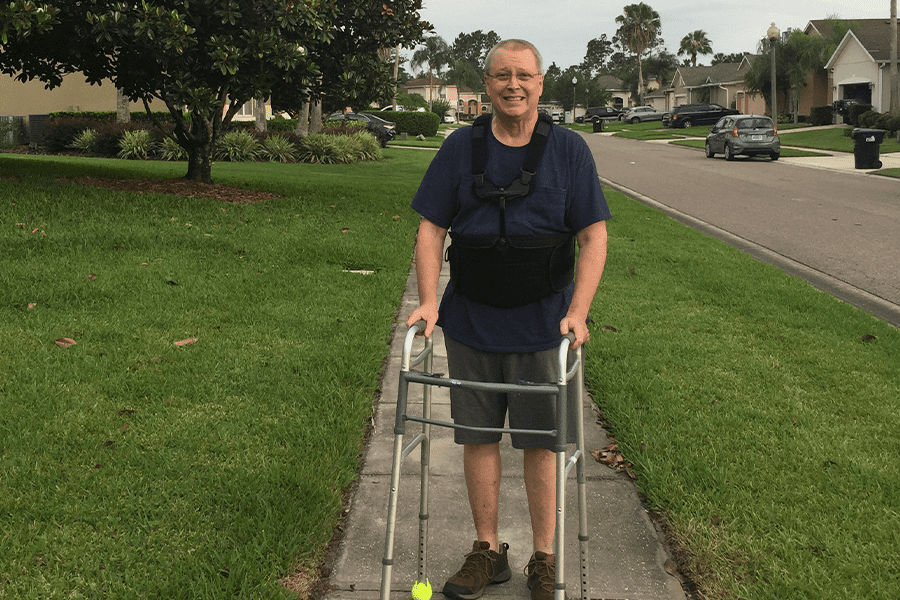Is a Laminectomy a Major Surgery?
- What is laminectomy surgery?
- What’s it like to recover from laminectomy and spinal fusion surgery?
- Why would a patient need a laminectomy?
- Is laminectomy right for you?
You probably don’t think about the importance of your spine health in relation to all the tasks you do every day. That is, until something goes wrong.
Aron had L5-S1 disc fusion and L5-L4 laminectomy surgery with Steven E. Weber, D.O., board-certified orthopedic surgeon at Orlando Orthopaedic Center.
Before the surgery, Aron’s back pain was so bad he couldn’t do even the simplest of tasks like cooking or driving a car. Even standing up for more than a minute was just too painful.
Today, Aron says, “It sounds crazy—these are just simple things, but they mean a lot and you can get them back.”
If a laminectomy is required to provide relief, is it a major surgery? Let’s find out.
What is Laminectomy Surgery?
 A laminectomy is a surgery used to treat central spinal stenosis, or the narrowing of the spinal canal. During the procedure, a surgeon removes a portion or all of the lamina, or the posterior of the spinal vertebra to allow more space for a spinal cord and nerves that have been compressed. This could involve removing bone spurs or part or all of the disc. One or more vertebrae may be treated in this way. Spinal fusion may be done at the same time.
A laminectomy is a surgery used to treat central spinal stenosis, or the narrowing of the spinal canal. During the procedure, a surgeon removes a portion or all of the lamina, or the posterior of the spinal vertebra to allow more space for a spinal cord and nerves that have been compressed. This could involve removing bone spurs or part or all of the disc. One or more vertebrae may be treated in this way. Spinal fusion may be done at the same time.
The laminectomy surgery eases spinal cord pressure and pain. The success rate of this surgery is high; 85% to 90% of surgical patients find the procedure eliminates their leg pain and 75% of patients say they have much better quality of life for a decade after the surgery.
There are two primary types of laminectomy:
- Bilateral laminectomy, where both sides of the affected vertebra are removed
- Unilateral laminotomy, where one side of the affected vertebra are removed
These procedures can be performed by using a small tube called an endoscope in a type of minimally invasive procedure. In some cases, the vertebrae are fused to help with overall spinal stability. The fusion procedure involves putting titanium screws and rods to form a solid construct in the spine.
In late May, 2020, Aron underwent the laminectomy and fusion procedures with Dr. Weber.
Aron says, “The biggest benefit of the surgery was I can wake up in the morning rested.” He says, “I feel great. It was really life-changing.”
What’s it Like to Recover from Laminectomy and Spinal Fusion Surgery?
 After surgery, you will be taken to the recovery room and carefully monitored. Typically, you will recover in a hospital setting and most patients begin walking several hours after their surgery. Pain is controlled by medications even when you transition back to home care.
After surgery, you will be taken to the recovery room and carefully monitored. Typically, you will recover in a hospital setting and most patients begin walking several hours after their surgery. Pain is controlled by medications even when you transition back to home care.
You should expect your back to feel sore and stiff. Standing or sitting for long periods may be hard as healing takes place so patients are encouraged to shift their positions every 30 minutes or so when standing or sitting. Recovery usually extends up to six weeks before one can resume light chores or activities and full recovery can take up to a year.
Some patients may wear a back brace and most will go to physical therapy to regain their mobility and strength. If your job isn’t manual labor, expect to go back to work after one or two months. For physical laborers, returning to work can take six months.
You can expect to be counseled and monitored carefully as you recover at home. You will be encouraged to walk a little each day, slowly increasing the distances. Walking boosts the body’s blood flow and aids healing. You’ll need to avoid lifting, whether it’s a grocery bag or the vacuum cleaner, and avoid strenuous activities like weight lifting or jogging. Most patients cannot drive for up to four weeks after surgery.
Aron says, “I’m basically six months post-op, and I know recovery takes time. This was expected.” However, every patient heals at their own pace.
Why Would You Need a Laminectomy?
 Pain and a lack of mobility are often the two primary reasons for the laminectomy procedure. Aron says, “My leg was going numb. I knew something was wrong and it was getting worse.”
Pain and a lack of mobility are often the two primary reasons for the laminectomy procedure. Aron says, “My leg was going numb. I knew something was wrong and it was getting worse.”
The spine is a highly complex structure. Within the spinal column lie a myriad of nerves that can cause excruciating pain when they are compressed.
That’s what happened to Aron. He says, “I went to the ER. I was experiencing level nine pains for two-hour periods, four to five times a day for three days straight.”
Spinal pain can limit movement and function. While conservative treatments, such as medications and physical therapy, are typically tried first, some patients can benefit from laminectomy to alleviate their pain and restore their mobility.
Some of the typical medical treatments to alleviate pain before surgery is attempted include:
- Assisted devices including walkers or back supports
- Changing lifestyle and activities
- Medications such as anti-inflammatories, muscle relaxants, and pain relievers
- Physical therapy and rehabilitation
- Spinal injections
- Weight loss and/or smoking cessation
If these treatments no longer work, a laminectomy procedure can ease the pressure on the nerves within the spine, help with a spinal disc issue, or remove a spinal tumor. The results can be dramatic. Aron says, “My pain levels have gone from nine to 10s to zeros or ones.”
Is Laminectomy Right for You?
Laminectomy and fusion surgery can provide relief for patients experiencing the pain of herniated discs or spinal compression. The laminectomy and spinal fusion procedure that Aron underwent completely changed his life for the better. However, the decision to undergo surgery is never easy.
Aron says, “Dr. Weber is the type of doctor who cares about your well-being. Never once was I rushed into a surgery decision.”
Like a lot of patients, Aron was pleasantly surprised by the COVID safety protocols when he first visited Orlando Orthopaedic Center. He says, “Safety protocols mean a lot to me. It’s nice to see they felt the same way.”
Aron is well on his way to recovering his life after having the laminectomy surgical procedure. He has no regrets about his decision and says, “Thank you, Dr. Weber. You and your staff are amazing. I am so glad that he is my doctor. He literally saved my life.”


